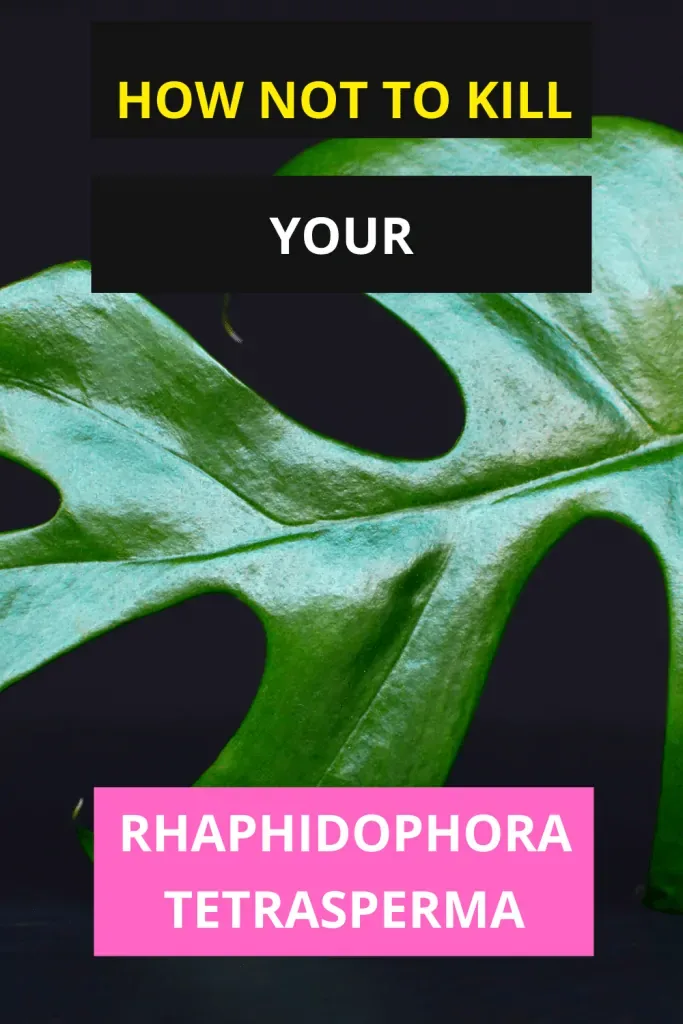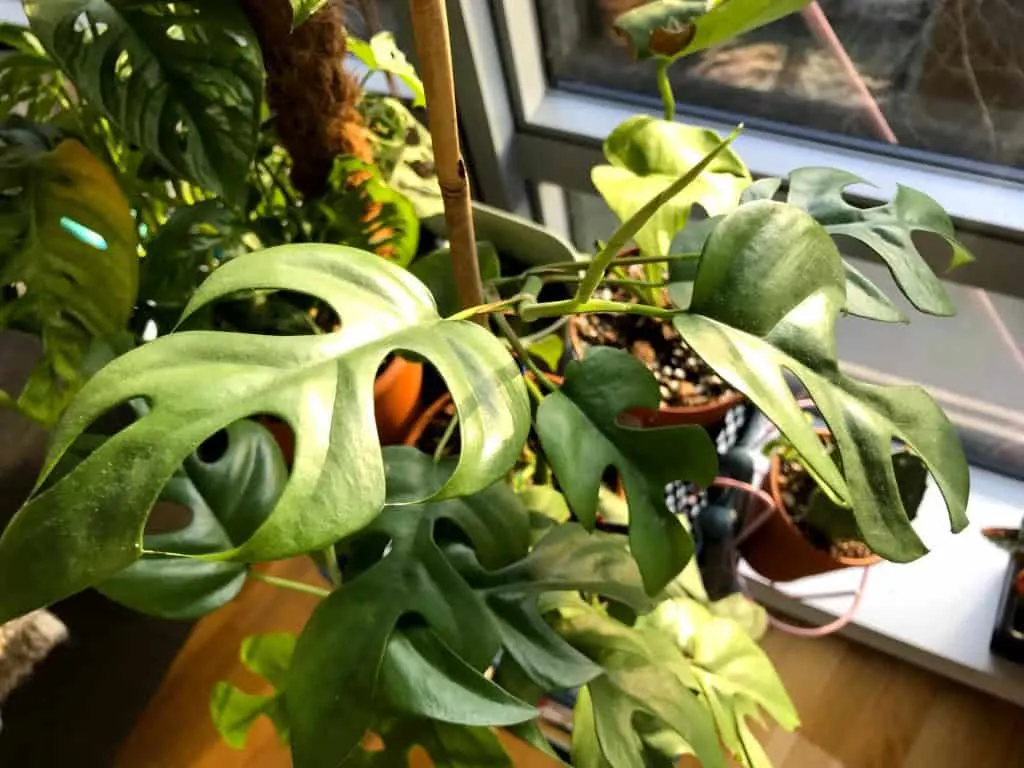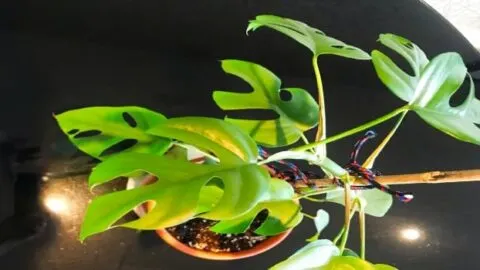We are big Monstera fans here on Plantophiles, there’s no denying that.
But we certainly do also have lots of love for the Rhaphidophora tetrasperma, which is commonly known as the Mini Monstera and belongs to the Araceae family according to the International Plant Name Index.
One quick look at the plant is sure to reveal why this plant actually has got that nickname.
Yes, it is because it looks very similar to one of our favorite houseplants ever, the marvelous Monstera deliciosa.
Rhaphidophora Tetrasperma Care
The ideal temperature for a Rhaphidophora tetrasperma lies between 60 to 75 degrees Fahrenheit (16 to 24 degrees Celcius). The Humidity should be at least 50%. 60% and more is ideal. Use well-draining soil using a chunky medium such as Coco chips. Bright indirect sunlight is an ideal choice. Fertilize monthly in spring and summer with a balanced fertilizer.
Did you know
Recently there have been Variegated Rhaphidophora tetrasperma popping up on the internet. These go for a ridiculous amount of money (>$5000 or more) since they are still much rarer compared to the popular Monstera deliciosa variegata.
Let us now find out together how to take proper care of the Rhaphidophora tetrasperma!
Table of Contents

Rhaphidophora Tetrasperma Plant Care Guide
SOIL
As far as soil goes, you need to make sure that you are going with a soil mix that is airy and well-draining.
Coco chips are a great choice here if you can get your hands on these! You could make it one half potting soil, one half coco chips, for instance. When propagating, you could also go with Coco Chips only.
A potting mix specifically for aroids is how plants from the Araceae family (such as Monstera and Philodendron plants) will yield great results.
Don’t choose dry soil or sandy soil. Your Rhaphidophora tetrasperma won’t like that at all!
LIGHT
For best results, provide your Rhaphidophora tetrasperma with bright, indirect sunlight.
If you are not a seasoned houseplant enthusiast just yet, the terminology all-around light levels and plants can be a bit confusing.
But please, don’t worry. Plantophiles got you covered.
Just head over to our light levels guide and you will become an expert on light level vocabulary in no time!
WATERING
Keep the soil evenly moist, yet not soggy. Waterlogging needs to be omitted.
During the growing season, Rhapidophra tetrasperma likes to drink more water. Water about once every week when the soil is just slightly moist. In winter, water less.
As far as the choice of water goes, rainwater is certainly a good choice. Distilled water is also fine. If you are using tap water, then make sure to use lukewarm water.
Also, if you are using tap water, it is always a good idea to let that water rest (in a cup) for a day or so before watering your plant.
As always with houseplants, you will want to make sure that you are actually using pots that have drainage holes!
While this might seem very obvious to you, it still can’t be dressed enough as I still see so many plant pots & planters on sale that actually come with no drainage holes at all.
Do yourself a favor and get a proper pot with drainage holes. Your Mini Monstera will certainly thank you for that!
TEMPERATURE
Your Rhapidophra tetrasperma will thrive best in a warm, humid environment.
As far as the temperature goes, the average room temperature is great.
Temperatures between 60 to 75 Fahrenheit (16 to 24 degrees Celcius) are ideal.
If it is a tad warmer, up to 80 Fahrenheit (up to 27 degrees Celcius), that’s still no problem at all.
HUMIDITY
As a tropical plant, Rhaphidophora Tetrasperma enjoys a good deal of humidity. Keep the humidity above 50%. 60% and more is ideal.
Now, as the average household humidity might be a bit low for this plant, there are a few things you can do to increase the humidity.
First of all, you can put your Rhaphidophora tetrasperma on a trey with damp pebbles. This is already going to help quite a bit to elevate humidity levels.
Another thing you could do is to move your plant to the bathroom, as the bathroom is generally the room with the highest humidity.
However, this is only an option if your plant still has access to enough sunlight (remember: your tetrasperma needs bright, indirect sunlight!).
That said, if your bathroom does not provide your plant with enough sunlight, then this won’t work.
Last but not least, regular misting of your Mini Monstera is yet another measure you can take to increase the humidity.
But it needs to be said that misting the leaves of your plant will only have a short-term effect as far as elevating the humidity goes.
It is certainly a good thing to regularly mist your plant but this should not be the only measure you take to increase humidity levels.
Oh, and you could certainly also just buy a humidifier to meet the humidity needs of your Rhaphidophora tetrasperma.
FERTILIZER
No surprises as far as fertilizing your Rhaphidophora tetrasperma goes.
During the growing season, feed your plant with a balanced liquid fertilizer about once a month.
As always when feeding your plants, err on the side of caution. Rather under-fertilize than over-fertilize.
A slow-release organic fertilizer is to be preferred, as fertilizer burn is not uncommon with the Mini Monstera.
PROPAGATION
Propagating a Rhaphidophora tetrasperma is a pretty easy task. You can multiply this beautiful plant through stem cuttings.
When taking your stem cuttings, make sure that these include at least one node (better two or three). If there’s no node, there will be no rooting.
Now, once you took the stem cuttings, you can either put them directly into fresh soil or you can also put them into water.
This could either be water only or it could also be water enriched with sphagnum moss.
I have personally been more successful with adding some sphagnum moss to the water. If it’s only water, it’s harder for your plant to form roots.
Instead of rooting the stem cuttings in potting soil, you could also root them in coco chips only.
This method proved to be very successful for me. As always when propagating, please be patient.
The propagation process will take a couple of weeks, so you need to be patient until new roots will form.
Also, please be aware that taking stem cuttings will stunt the growth of the mother plant.
So it is generally a good idea to let the plant grow quite a bit before propagating it.
GROWTH
Rhaphidophora tetrasperma is a very vigorous grower, even when grown as a houseplant.
As the Mini Monstera is a climbing plant, you should try to make its life easier by providing it with climbing help such as a trellis or moss pole.
POTTING
If you don’t have a lot of experience with repotting, this might be a good time for you to have a look at our in-depth repotting article.
In this article, you will learn how to successfully repot your plant in four easy steps.
When potting (repotting your plant), you should always make sure to not use a pot too big because this will increase the likelihood that your plant will have to deal with root rot (one of the most common problems with the Mini Monstera).

At first glance, the Rhaphidophora tetrasperma does look a lot like the popular houseplant Monstera deliciosa. While these two plants are closely related and pretty similar to care for, the Rhapidophra tetrasperma is a smaller plant that features smaller leaves. This is also why it is commonly known as the Mini Monstera.
Rhaphidophora Tetrasperma Problems
Let us have a look at some of the common issues when dealing with the Mini Monstera.
Rhaphidophora Tetrasperma Problem #1: Root rot
If your Monstera is dying on you, chances are that it is because of root rot. While root rot is extremely common with all kinds of houseplants, the Mini Monstera is particularly prone to get root rot.
The most common reason for root rot is overwatering.
However, there are also other things that can go wrong with Mini Monstera care that can potentially lead to root rot.
Have a look at our root rot treatment guide to see what you can do if your lovely plant already has got root rot.
If you are unsure if your plant is suffering from root rot in the first place, take a gander at our root rot symptoms & causes article.
Rhaphidophora Tetrasperma Problem #2: Curling Leaves
If your Mini Monstera features curling leaves, this could be due to too low humidity.
As a tropical plant, your Rhaphidophora tetrasperma naturally enjoys a good deal of humidity.
To solve the problem, increase the humidity. Here are some ways to do just that:
- Mist your plant more regularly,
- Put your plant (with the pot) on a tray with damp pebbles
- Move your plant to a more humid location (bathroom if light requirements can be met)
- Buy a humidifier
Rhaphidophora Tetrasperma Problem #3: Droopy Leaves
Droopy leaves are another very common problem that you might face as a plant parent of the Rhaphidophora tetrasperma.
While there a couple of possible reasons why droopy leaves could occur on your plant, the most likely reasons are either over- or underwatering.
If you are sure that your watering routine is on point, check your plant (leaves) for plant pests such as spider mites or mealybugs.
These plant pests could also be the root cause of the droopy leaves, as these pests are sucking the sap out of your plant, which, too, can lead to droopy leaves.
Yet another reason why your plant may have droopy leaves are too high temperatures.
Rhaphidophora Tetrasperma Problem #4: Yellow leaves
Chances are that at least some of your houseplants feature some yellow leaves. It surely is one of these problems that most plant parents have to deal with at some stage.
As very often when it comes to houseplants problems, there are actually many different root causes that can lead to your plants exhibiting yellow leaves.
Some causes are more likely than others, though. So my (educated) guess would be that your plant is either getting too much sunlight or too much water.
Make sure to check our advice on “Light” and “Watering” (see above) to solve this problem.
Also, a couple of yellow leaves is not the end of the world and doesn’t necessarily mean that your plant is in a very bad condition. Please keep that in mind.
Rhaphidophora Tetrasperma: No fenestrations
One of the most striking features of the Mini Monstera is its split-leaves.
So what went wrong if your Mini Monstera just does not have any split-leaves?
Chances are that your plant is absolutely healthy but is just too young to have split-leaves yet.
That said, no fenestrations in leaves are a sign of the immaturity of your plant.
To make sure the fenestrations are developing as expected, provide your Mini Monstera with enough light and give it something to climb.
Rhaphidophora Tetrasperma Plant Pests
The Mini Monstera is not terribly susceptible to plant pests. The one pest that is most likely to attack your plant is spider mites.
Please read our guide on spider mites for spider mites control.
Another plant pest that might be interested in your Rhaphidophora tetrasperma is mealybugs.
In any case, when dealing with plant pests, the first thing you should do is to isolate your plant from your other houseplants, so that the infestation won’t spread over to your other plants.
Rhaphidophora tetrasperma FAQ
What does Tetrasperma mean?
Tetrasperma is Greek. “Tetra” means four and sperma means seed.
Is the Rhaphidophora tetrasperma a Monstera?
No. Rhaphidophora tetrasperma is not a Monstera but it looks pretty similar to a Monstera deliciosa. This is also why it is often called the Mini Monstera.
Is the Rhaphidophora tetrasperma toxic to cats?
In short, yes. Usually, when wondering whether a plant is safe or toxic to cats & dogs, the ASPCA is a reliable source to check. However, as far as the Rhaphidophora tetrasperma goes, a search at the ASPCA yields no particular results. But as the Mini Monstera belongs to the Araceae family (just like Monstera deliciosa), the plant is indeed deemed toxic to cats, as this is generally true for plants of the family Araceae.
Does the Mini Monstera produce flowers?
Raphidophora tetrasperma is indeed a flowering plant. However, when grown as a houseplant, this plant rarely produces any flowers due to unfavorable growing conditions.
Do you love houseplants with enormous green foliage? If so then the Alocasia wentii care article might be a great choice to read next.

Daniel has been a plant enthusiast for over 20 years. He owns hundreds of houseplants and prepares for the chili growing seasons yearly with great anticipation. His favorite plants are plant species in the Araceae family, such as Monstera, Philodendron, and Anthurium. He also loves gardening and is growing hot peppers, tomatoes, and many more vegetables.


